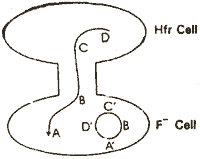(Paper) CBSE Class 12th Biology Exam Paper, 2003 (Compartment Delhi: Set-3)
Disclaimer: This website is NOT associated with CBSE, for official website of CBSE visit - www.cbse.gov.in
Paper : CBSE Class 12th Biology Exam Paper, 2003 (Compartment Delhi: Set-3)
SECTION - AQ. Nos. 1-8 are of very short answer type carrying 1 mark each Of these the first five questions are of multiple choice type which have to be answered simply as A, B, C or D The remaining questions have to be answered in approximately 1—20 words each
Q. 3. Pick ‘out the false statement with reference to cretinism.
(a) Failure of thyroid secretion in adult produces this disorder
(b) Physical and mental development in slow
(c) Metabolic rate is reduced
(d) Patient is not bellied
Ans. (d)
Q. 4. An example of monoecious plant is
(a) Tomato
(b) Rose
(c) Cucumber (cucurbit)
(d) Shoe-flower
Ans. (c)
Q. 5. A boy suffers from Haemophilia. What is true of the inheritance of this case’
(a) His mother could be normal (homozygous)
(b) His mother could be a carrier of this disorder
(c) He has inherited this disease from his father
(d) His maternal grandfather was normal
Ans. (b)
Q. 6. What s the special structural feature of brush-bordered cubical cells of proximal tubules of the nephrons?
SECTION - B
Q. Nos. 9-18 are of short answer type carrying 2 marks each Answer them in approximately 20-3 words each.
Q. 9. Mention the modified functions performed by
(a) underground stem of potato
(b) axillary bud of Bongainvillea
(c) Axillary bud of Bougainvillea: Modified in to spines for attachment or anchor.
SECTION – D
Q Nos. 28-30 are long answer type carrying 5 marks each Q Nos. 29 and 30 have internal choke. Answer these questions in approximately 80-120 words each.
Q. 28. (a) Schematically represent the various steps in cyclic photophosphorylation in Angiosperms.
(b) What is the function of carotenoids in the leaves?
(c) Hydrilla, a submerged green plant is supplied with sunlight and labelled C18 O2. In which compound will this heavier 0 as a result of photosynthesis? 2
Q. 29. (a) Through schematic diagrams, illustrate the stages of spermatogenesis.
(b) Why is the descent of testes from the abdomen into the scrotum significant in a human male?
(c) List any two events taking place in an ovum just when sperm gains entry into it.
Or
(a) Draw a portion of human alimentary canal showing the location of
digestive glands with their ducts opening into the duodenum. Label the
parts.
(b) Name the largest digestive gland in humans. Describe the functions of its secretion in digestion.
Q. 30.
A geneticist was tracing the inheritance of eye colour in Drosophila
flies. In one such cross, he crossed a red eyed female off generation
with a white eyed male
(a) Represent the cross showing the genotypes and phenotypes of the parents and progeny.
(b) What type of cross is this?
(c) Is the Inference drawn on the result of the cross?
(d) Comment on the inheritance of eye colour in these flies.
Or
Given below is a schematic representating of two interacting bacterial cells:

(a) Name the bacterium and describe the process illustrated
(b) What I, the use of such a process in genetics?
(c) Which of the two cells acts as a male
(d) Draw a labelled diagram of the stage immediately next to the one shown here.